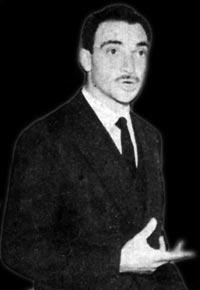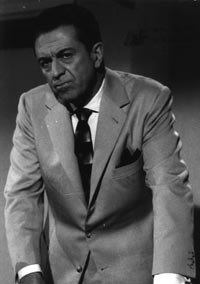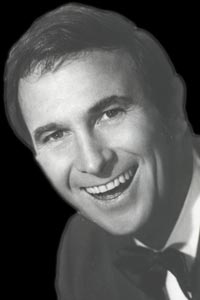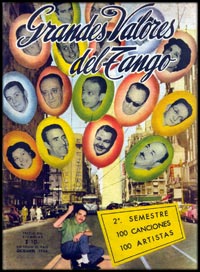By
Grandes Valores del Tango, a break and a “quebrada”

n the history of the Argentine television, this creation by Alejandro Romay was, without a doubt, the most successful show which aired our Buenos Aires music, the one that attained longest permanence in time.
 No other program succeeded in lasting nearly forty years on the small screen, despite it was aired largely, during the worst period of the genre.
No other program succeeded in lasting nearly forty years on the small screen, despite it was aired largely, during the worst period of the genre.
In the late 1963, with Hugo Del Carril as emcee, Grandes valores del tango (Great Figures of Tango) began on Channel 9, precisely at the same time that Alejandro Romay ventured for the first time into television. However, its origin dates back to 1951 when it started on LS10 Radio Argentina and LR9 Radio Antártida, with Romay himself as conductor. The program was so successful that a magazine with its same name was published.
Less than a year after its television debut, Juan Carlos Thorry replaced Hugo Del Carril. It had become a true hit. Its sponsor was Héctor Peres Pícaro S.A. —a shop of household appliances whose slogan was: «the good luck clover»—. The program was aired, generally on-line and live, from the Channel 9's largest studio, a place with tango tradition, because at that same place or very near, the famous Armenonville used to be located.
Important artists paraded from the start, but only those that were not signed with other media. The show reached larger audiences when consecrated stars showed up.
However, the passing of time was deteriorating the program's following, but its producers always found the way of keeping the appeal for those that love the city music.
Tango was present from the beginning of television, back in 1951. But perhaps because its start was linked to Radio Belgrano and not to Splendid or El Mundo, the genre never stood out in that medium, for which, unfortunately, they did not take advantage of the availability of many great artists in the best period of their careers.
Only in 1962, Channel 11 aired Yo te canto Buenos Aires, produced for Ricardo Mejía, the RCA Victor’s boss. It was the first television program in which the recording companies made use of the artists in order to promote and advertise their records. It was there where our country was able to watch Roberto Goyeneche singing for the first time “Garúa” with the Aníbal Troilo's orchestra.
 Soon thereafter the rest of the companies promoted new spaces in other media. It was then when Horacio Salgán (Philips records) put together again his orchestra to appear on TV and to resume recording the largest part of his repertoire. Meanwhile Channel 13 launched the program Copetín de Tango, a CBS's production Columbia to promote Julio Sosa's records.
Soon thereafter the rest of the companies promoted new spaces in other media. It was then when Horacio Salgán (Philips records) put together again his orchestra to appear on TV and to resume recording the largest part of his repertoire. Meanwhile Channel 13 launched the program Copetín de Tango, a CBS's production Columbia to promote Julio Sosa's records.
The restrictions of the beginnings ended up in 1964 and Grandes valores del tango opened its doors to all the artists. Floreal Ruiz, Héctor Mauré, Alberto Morán, Enrique Dumas, Guillermo Galvé and so many others appeared there.
Thorry was its most recognized emcee. When the need of a change came, Alejandro Romay followed an interesting strategy. In order to draw the attention of young audiences he placed Silvio Soldán as the program conductor, who by that time was a boom as emcee of Feliz domingo (Happy Sunday), a TV show for teenagers. The story which originated the Glostora tango club is repeated. Its slogan was: «The date of the triumphant youth».
 Every time that the charismatic Soldán had to make a pause for the commercials, he used to say the remembered sentence: «A break (corte), a quebrada (alluding tango dancing steps) and soon we’ll be back».
Every time that the charismatic Soldán had to make a pause for the commercials, he used to say the remembered sentence: «A break (corte), a quebrada (alluding tango dancing steps) and soon we’ll be back».
Various circumstances forced to gradually modify the initial structure, but always preserving the participation of Tito Lusiardo, Alberto Mosquera Montaña, Roberto Cassinelli, Beba Bidart and other dear characters. That way, the program went dodging adversities.
Channel 9, like almost all channels, had a staff orchestra which was conducted by Armando Cupo, one the founders of the Sextet Mayor. There were dancers and singers that were included and renewed permanently in the cast. They were accompanied by the most famous aggregations that were showcased in the program or by the staff orchestra. Regrettably, that amazing blend of talents was never recorded.
We cannot go on without remembering the talent contests for singers that were so important in the program. From those renowned interpreters, that still today delight us, sprang up: Ricardo Chiqui Pereyra, Juan Carlos Granelli, Gloria Díaz and many more. Other ones, unfortunately, are gone forever but their figures have remained attached to the memory of this program.
When in 1974 the government made all media state-ow ned channels, Grandes valores del tango had to change its name for Grandes valores de hoy y de siempre (Great Figures of Today and Always).
ned channels, Grandes valores del tango had to change its name for Grandes valores de hoy y de siempre (Great Figures of Today and Always).
Then Romay lost his channel. It is important to emphasize that he was a businessman that opened his microphones and his cameras to all the artists, regardless of their ideology. The homages paid to Osvaldo Pugliese, to Tita Merello and to other interpreters are an example of that behavior.
During the darkest and saddest hours of ourhistory, the airing went on. Always we had the impression than, despite the tragic events that took place in our country, Grandes valores del tango did not suffer bigger damage. Of course it was hit by the passing away of a large number of artists throughout its long tenure. When democracy was back, a painful event muddied the joy of tango men, at the end of December 1983 and due to his own decision, Armando Pontier put an end to his life.
Unfortunately, with the passing of time, the show's filesgot lost or, at least, today they are unavailable. It would be a good thing if some businessman would invest in his quest. The best of Grandes valores del tango is contained in that past recorded in black and white.
With Romay's comeback to his old channel, Grandes valores del tango recovered its name and, for ten years, intended to recover its previous splendor. He fought to achieve it and, at first, the rating was in his favor, but finally the show could not compete with the programs of the other media and all was over. Furthermore, soon thereafter, the businessman ended up selling his beloved channel.
Romay was frequently accused of producing vulgar television programs. Was it all really vulgar or was it because he straight reached the people’s heart?
Today there are a great diversity of channels of all kinds —standard, satellite, digital, cable— and among the latter, a mediocre channel devoted to tango, produced by untalented people and without budget. We should ask ourselves then, what does television offer today? Especially if we think that, either in its peak or much later, Grandes valores was aired at the time of a television with few canals, four or five at the most.
In short, the one who writes this would give anything to watch again Grandes valores del tango, in black and white, and with the unforgettable Juan Carlos Thorry as conductor.
Version adapted to All Tango's format, of a completely published note in the Buenos Aires Antiguo site – Section Vereda de Tango, November 2007.